The narwhal is a carnivore endemic to the Arctic, in winter they prey on the seabed at depths of about 1,500m beneath thick ice. For more than a thousand years, the Eskimos of northern Canada and Greenland have hunted these animals for meat and ivory. Join Toplist to learn more interesting information about this animal!
Description Information
The English name of the narwhal is narwhal or narwhale, the scientific name is Monodon monocerus. This is a medium-sized whale, they are famous for their shape like having a long spiraling horn in front of their head, which makes many people think of mythical unicorns. This is also the reason why they are called narwhal.
The word narwhal comes from the Norse language. In it, nar means corpse, combined with whal means whale. The narwhal gets its name from the grayish-white color of the whale's spots, which makes them somewhat resemble a drowned corpse. As for the narwhal's scientific name, Monodon monocerus comes from the Greek phrase meaning "one tooth and one horn". Why is it a one-horned tooth, please continue to discover interesting funfacts about the "horn" of the narwhal later.
Description of the narwhal species:
Common name: Narwhals
Scientific name: Monodon monoceros
Class: Mammals
Distribution: Arctic region
Lifespan: Unicorns can live up to 50 years.
Size: Length about 5.1 m
Weight: Up to 940 kg
Conservation Status: Near Threatened
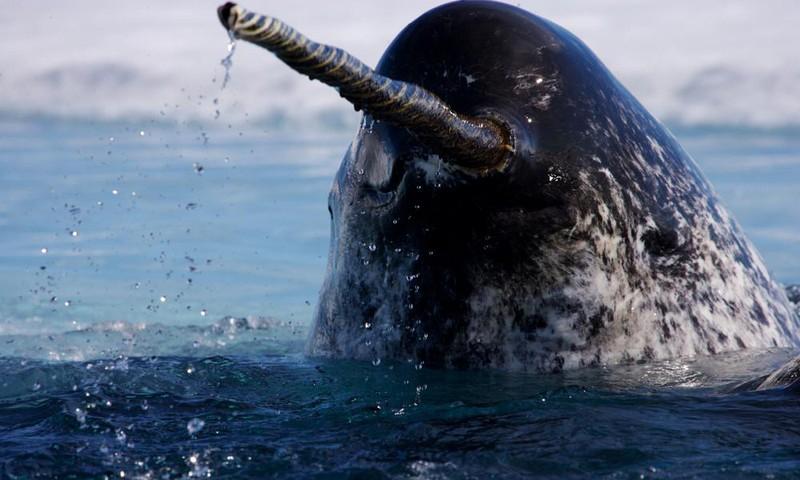
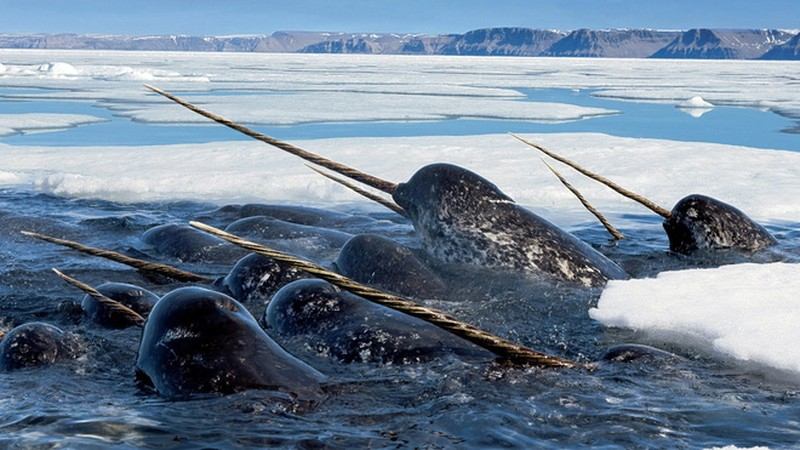
Taxonomy and genetics
The narwhal (Monodon monoceros) (English: Narwhal) is a medium-sized marine mammal in the suborder Odontoceti, living year-round in the Arctic. Along with the white whale, they are the only two extant species in the family Monodontidae. The characteristic feature of narwhals is that males have a long, straight, twisted tusk in their upper left jaw (hence the name "unicorn").
They are found mainly in the waters of the Canadian Arctic Ocean and around the island of Greenland, but rarely below 65° North latitude.
The narwhal is very closely related to the white whale. Together, they are the only two remaining species of the family Monodontidae (sometimes called the Great White Whales). The family Monodontidae is described as medium in size (3–5 m in length), with a watermelon-shaped forehead, short snout, and no true dorsal fin.
The Monodontidae (the white whales) together with the Delphinidae (ocean dolphins) and the Phocoenidae (the porpoises) form the superfamily Delphinoidea.
Genetic evidence suggests that the porpoises are more closely related to the white whales than the oceanic dolphins, and the two families form a separate clade that diverged from the Delphinoidea superfamily within 11 million years. via

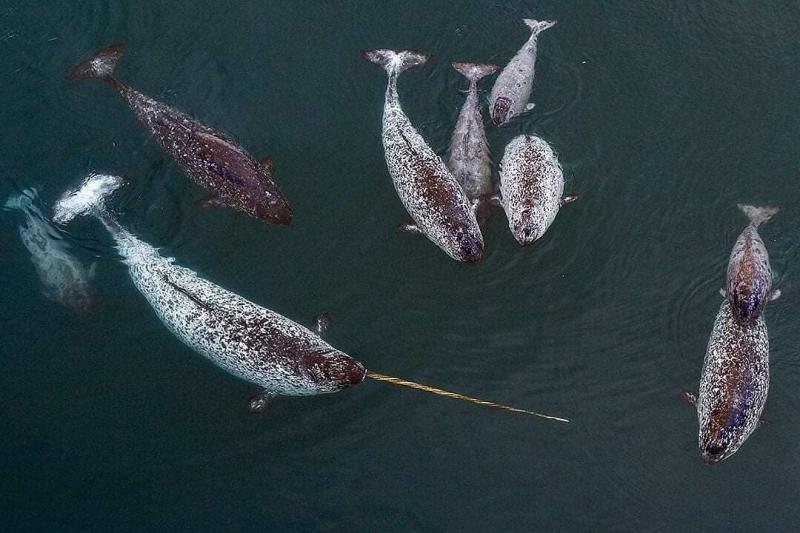
Appearance characteristics
The narwhal is a medium-sized fish. For both sexes, body size can range from 3.95 to 5.5 m; Males have an average length of 4.1 m, slightly larger than females, with an average length of about 3.5 m. The body weight of an adult unicorn ranges from 800 to 1600 kg.
The narwhal has dark dorsal skin with many brown spots and a bright white belly. Their skin color is dark, dark at birth and becoming lighter as they get older. White patches develop on their abdomens and genitals in adulthood. The skin color of old narwhals is almost pure white. The narwhal has no dorsal fin, possibly an evolution to adapt to swimming easily under layers of ice. The cervical vertebrae are straight, like those of land mammals instead of being fused together like most whales.
The most recognizable feature of the male unicorn is a long spike that rises from the upper jaw and extends past the lips to form a spiral. The fangs grow throughout life, reaching a length of about 1.5 to 3.1 m; hollow and weighs about 10 kg. At a 1:500 ratio, one out of every 500 males has two fangs. Only about 15% of females develop fangs, which are often smaller than males and are less noticeable. The fangs are sensory organs with millions of neural structures. They are used to help locate prey and demonstrate male dominance. Indigenous cultures believe that their tusks have magical powers.

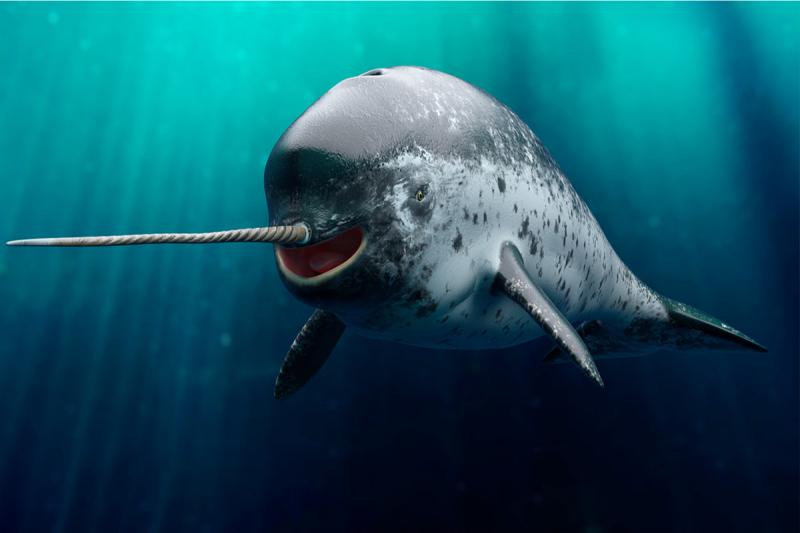
Living habits
The narwhal can stay underwater for 25 minutes and dive 1500 meters before emerging from the surface. They usually move in groups or groups of 2 to 10 individuals to forage. Sometimes, they even gather in herds of hundreds or thousands if there is a lot of food in that area.
Unicorns are mobile, they migrate seasonally and only return to their "ideal" area each year. In winter, in search of food, they will move south – areas with shallow water, near the coast. And when it's summer, they turn north again - where the deep waters are covered with white snow.
Unicorns can live up to 50 years. They hide under ice or stay underwater for long periods of time to escape predators, instead of running away. The narwhal's natural enemies are polar bears, walruses, killer whales, and Greenland sharks. Besides, humans are also a threat to this species because hunting activities are taking place excessively.


Diet
The narwhal has a relatively limited diet. Its prey mainly includes Greenland halibut, polar cod, arctic cod, shrimp and squid Gonatus. Other foods found in their stomachs include wolffish, capelin, skate roe and sometimes rocks (which they inadvertently swallow while feeding on the bottom). Unicorns are also special predators, they eat a lot during migration.
The narwhal has a rather special way of hunting, they will use sound waves to navigate and hunt for prey. They have an element that acts as the acoustic lens called a melon. When they emit a cry, the whistle is echoed, immediately their melon area will analyze this data, thereby giving information about the situation of the surrounding prey.
With a body weight of up to 900kg, they eat a lot during their migration. Their favorite food is Greenland halibut, arctic cod, squid, shrimp…
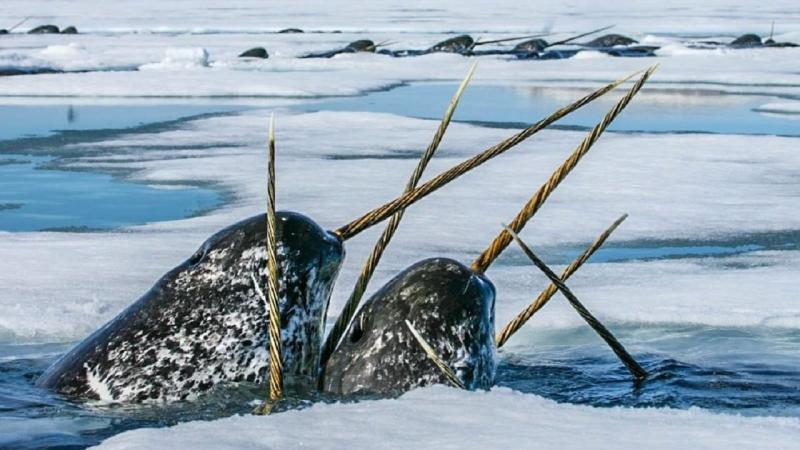
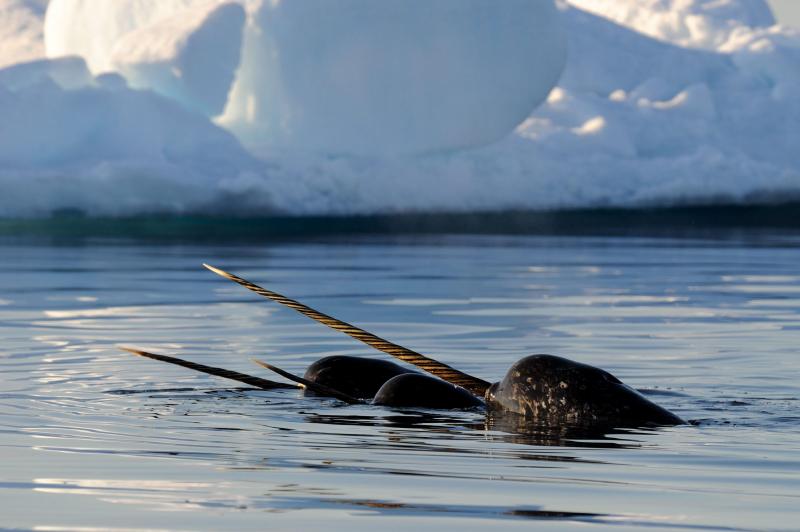
Reproduction mode
The narwhal mating season is only 3 months, starting in March and ending in late May. However, the breeding process is quite long, averaging about 15.3 months. The young will be born in July or August next year.
The narwhal is a calving species, the only offspring born will be completely dependent on the mother. The baby narwhal will be breastfed for the first 12-20 months. The young will always swim next to the mother to learn all the necessary skills until they can live independently, not depending on the mother anymore.
Male maturation is between 11 and 13 years old, at which point they will be about 3.9 meters long. Unlike males, female narwhals will mature earlier between 5 and 8 years old when the length reaches about 3.4 m.
Unicorns usually gather in groups with about 5-10 individuals. During the summer, several groups merge together, forming a larger aggregate. Sometimes, male narwhals rub their tusks together in an activity known as “tusks fighting.” This behavior is thought to maintain social hierarchy.
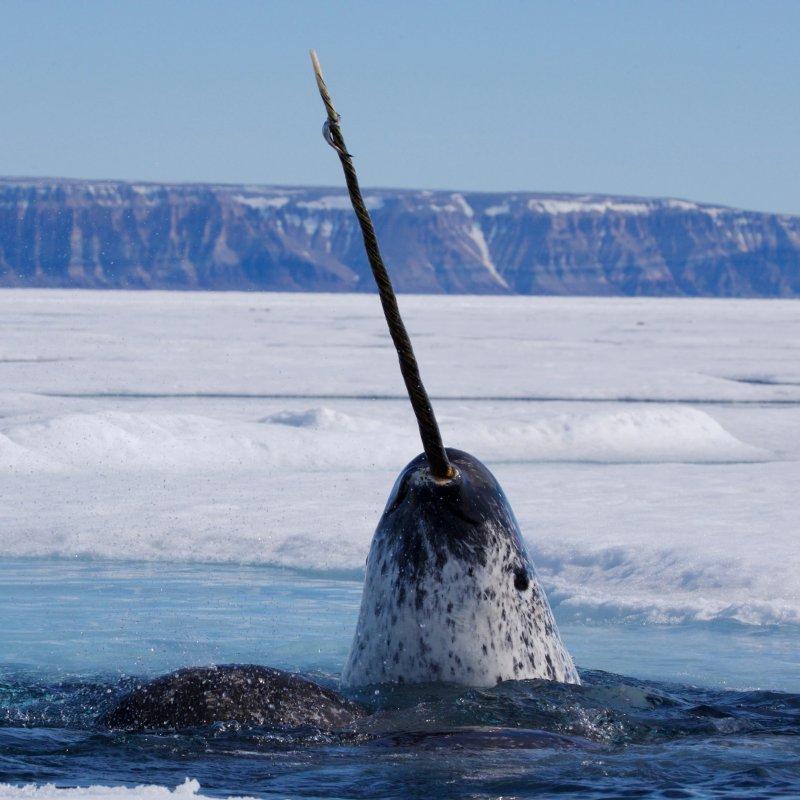
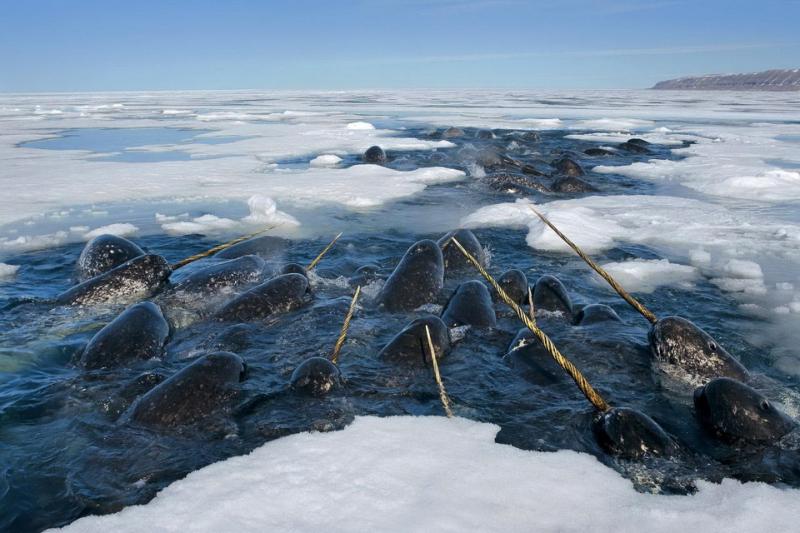
Distribution
The narwhal is distributed mainly in the Atlantic and arctic oceans. They are commonly found in northern Hudson Bay, Hudson Strait, Baffin Bay; off the east coast of Greenland; and in a strip running eastward from the northern end of Greenland around eastern Russia (170° East).
Currently, the number of narwhals is estimated at about 75,000 individuals. Most are concentrated in the fjords of northern Canada and western Greenland.
The narwhal is a migratory species. During the summer months, they move closer to the coast, often in groups of 10-100. When they begin to freeze in winter, they move far from shore, and reside in dense ice, relying on small ice gullies and craters. When spring arrives, the trenches turn into canals and the narwhal returns to the old bays and shores.
In winter, between November and March, most unicorns, about 70,000, migrate to Baffin Bay and Davis Strait between Canada and Greenland and stay there for six months. Other groups spend their summers in fjords along East Baffin Island, Hudson Bay, and West and East Greenland. Their migration takes about two months.
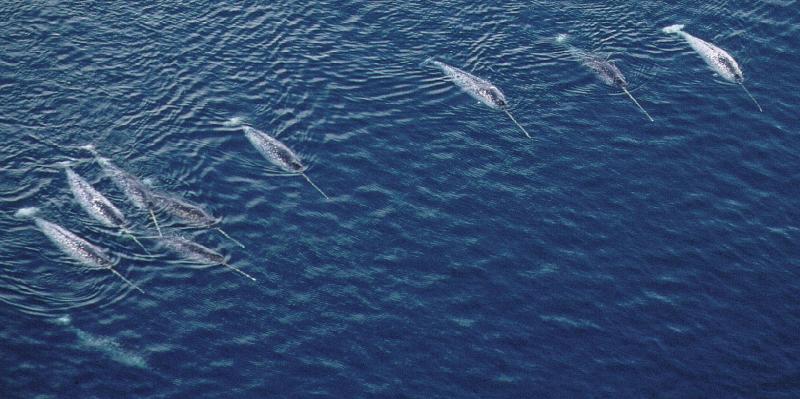
The tusks of the narwhal
The part that looks like a narwhal's horn is actually a special tooth. This is a spirally developed canine and elongated protrusion, similar to ivory. A male narwhal has only one tusk that elongates. The tusk grows throughout the life of the narwhal and reaches a length of 1.5 to 3.1 m with a weight of about 10 kg.
Most male narwhals have left tusks, only about 1 in 500 males develop right tusks. Meanwhile, only 15% of female narwhals have tusks. The tusks of the female are smaller and not spiral. Only one previously documented case of a female narwhal had two tusks.
Initially, scientists thought that the tusk evolved as a weapon of competition between males. However, the recent theory supports that the tusks are rubbed together to convey information. In these tusks also develop unique nerves that help them perceive information about seawater.
Maybe the narwhal's tusk is a sex-attractive feature. Like the mane of a male lion or the tail feathers of a peacock. It can help define social ranks, maintain dominance hierarchies, or help young males develop the skills needed to perform in sexual roles.
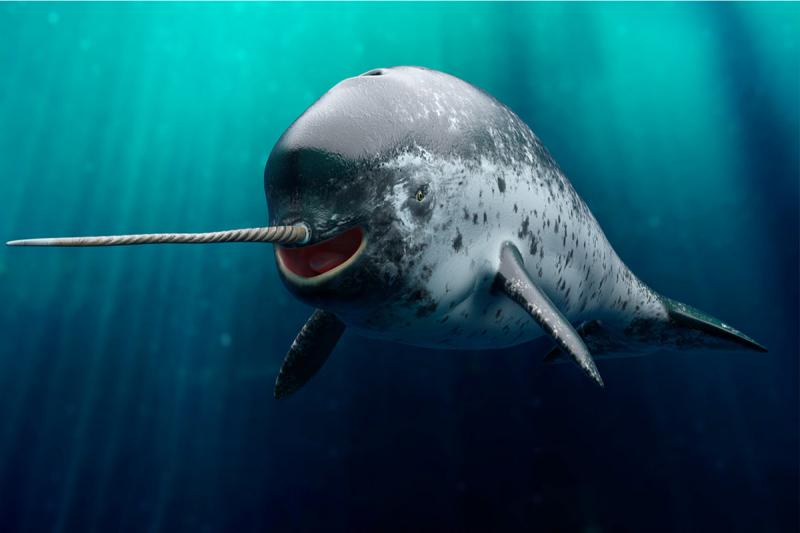
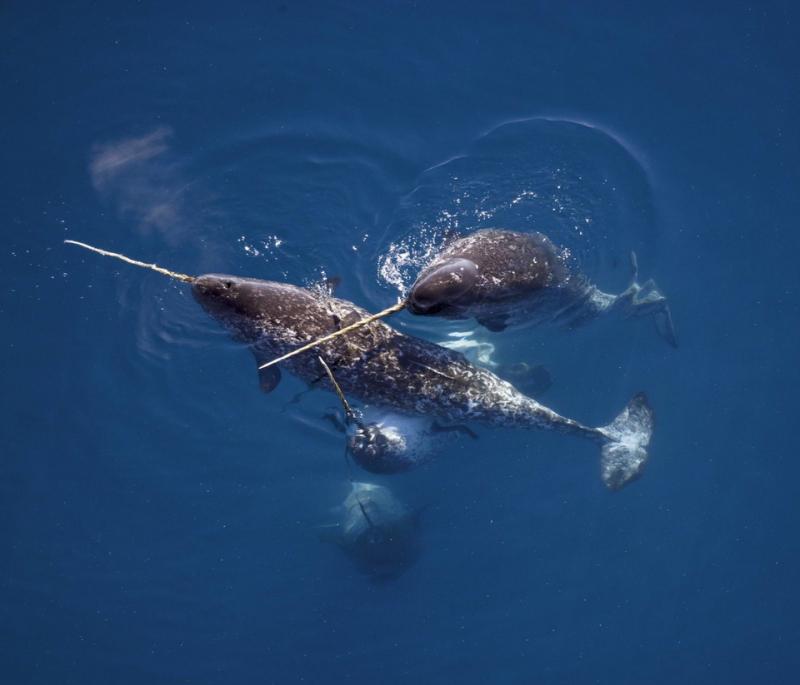
Hunting and conserving
The enemies of narwhals besides humans are polar bears and killer whales (Orca). The Inuit (Eskimo) are allowed to legally hunt whales for subsistence. Almost all parts of the narwhal meat, skin, fat and organs are consumed. For the Inuit of Greenland, the narwhal provides vitamin C through its fat and outer skin, a vitamin considered rare in this inhospitable land. Without them, the Inuit might not have survived.
The people of Greenland are allowed by the government to hunt narwhals, but are not allowed to hunt the females and have to take the carcasses away after killing them. Greenland bans the export of narwhal ivory and the European Union also bans the import of this rare commodity. However, many people still hope to shoot a narwhal with tusks that can sell for more than $1,000. In addition, hunters also look forward to obtaining what they call "muktuk", located above the fat and skin, which is valued as a traditional delicacy.
In the Middle Ages, narwhal tusks were worth 10 times its weight in gold. Queen Elizabeth I was once offered a gem-carved ivory worth £10,000 (about £1.5 million to £2.7 million in 2007), enough to buy a castle. Currently, a piece of ivory 30 cm long also costs up to 125 USD. In recent years, an average of 500 narwhals in the Canadian Arctic have been killed each year.
The narwhal is considered one of the most vulnerable arctic marine mammals to climate change. Unicorns brought into captivity tend to die of natural causes.


Unicorns in human culture
The narwhal is a carnivore endemic to the Arctic, in winter they prey on the seabed at depths of about 1,500m beneath thick ice. For more than a thousand years, the Eskimos of northern Canada and Greenland have hunted these animals for meat and ivory.
Some medieval Europeans believed that the narwhal tusks were the horns of the mythical unicorn.
Unicorn horns (in mythology) were considered to have magical powers, such as the ability to cure poisoning and depression, and the Vikings and northern merchants who seized the opportunity were able to sell they are worth many times the weight in gold of the tusk itself. Ivory is also used to make cups that are believed to neutralize any poison.
Herman Melville wrote a section on narwhals in Moby Dick, in which he claimed a narwhal tusk hung for "a long time" at Windsor Castle after Sir Martin Frobisher had given it to Queen Elizabeth. . The narwhal also appears in Jules Verne's Twenty Thousand Leagues Under the Sea.

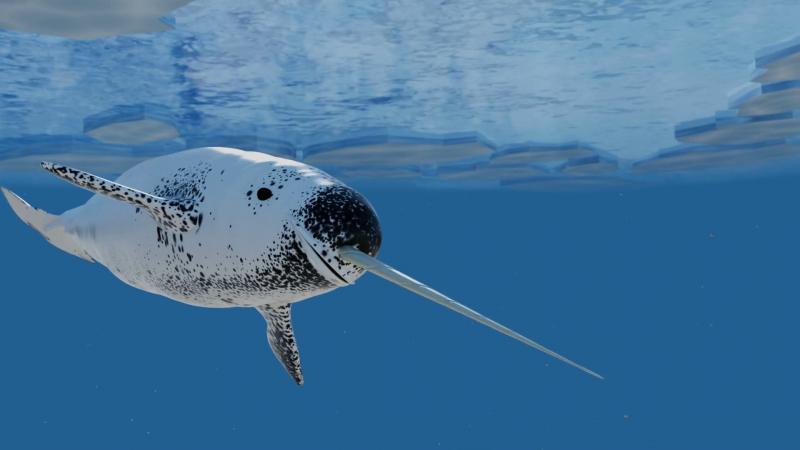
Some more information about Unicorn species you may not know
The narwhal is one of the most vulnerable arctic animals to climate change due to the recovery of ice cover in their habitat in the northern region.
Unicorns and white whales are close relatives.
No narwhal is in captivity. In the 60s and 70s, there were several attempts at keeping them in captivity but all died within a few months.
Despite its tough appearance, the narwhal's tusks are capable of remarkable sensitivities. With 10 million tiny nerve connections running from the nerve center of the dentin to the outer surface, the dentin is like a membrane whose outer surface is extremely sensitive and can detect very small changes in temperature. , sea water pressure. Since narwhals can detect small changes in water, they can sense the salinity of the water as well as fluctuations around their prey, and this will help them survive in the icy Arctic environment.
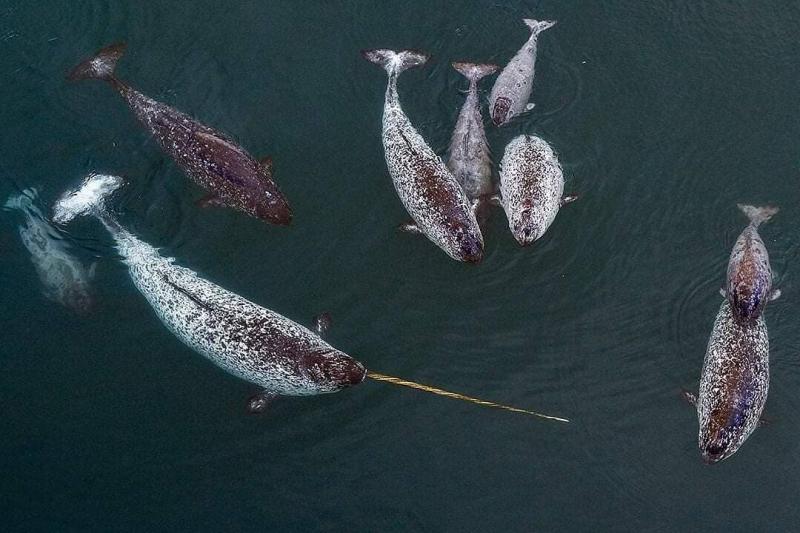
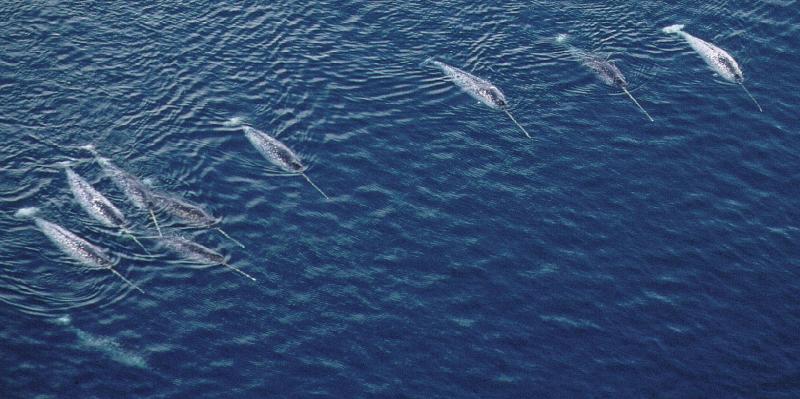
Through the article, Toplist has specifically provided about interesting things about narwhal species. Hopefully, the above information will help you know more useful and interesting information about the animal world.






